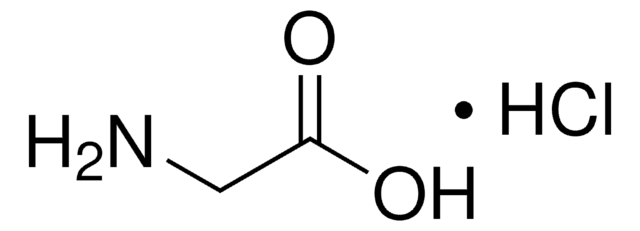G8898
Glycine
≥99%, suitable for western blotting
동의어(들):
Aminoacetic acid, Aminoethanoic acid, Glycocoll
로그인조직 및 계약 가격 보기
모든 사진(3)
About This Item
Linear Formula:
NH2CH2COOH
CAS Number:
Molecular Weight:
75.07
Beilstein:
635782
EC Number:
MDL number:
UNSPSC 코드:
12352209
eCl@ss:
32160406
PubChem Substance ID:
NACRES:
NA.28
추천 제품
제품명
Glycine, suitable for electrophoresis, ≥99%
Quality Level
분석
≥99%
양식
powder
기술
electrophoresis: suitable
western blot: suitable
불순물
≤0.01% Insoluble matter
색상
white to off-white
pKa(25 °C)
(1) 2.35, (2) 9.60
2.35
mp
240 °C (dec.) (lit.)
solubility
H2O: 200 mg/mL, clear, colorless to faintly yellow
음이온 미량물
chloride (Cl-): ≤70 ppm
양이온 미량물
heavy metals (as Pb): ≤20 ppm
흡수
≤0.15 at 280 at 1 M
작용기
amine
carboxylic acid
저장 온도
room temp
SMILES string
NCC(O)=O
InChI
1S/C2H5NO2/c3-1-2(4)5/h1,3H2,(H,4,5)
InChI key
DHMQDGOQFOQNFH-UHFFFAOYSA-N
유전자 정보
rat ... Grin2a(24409)
유사한 제품을 찾으십니까? 방문 제품 비교 안내
일반 설명
Glycine is a molecule with pI of 6.7, which is similar to the pH of stacking gel. It has advantage of low mobility, hydrophobicity and it does not associate with proteins. Glycine is a component of Tris-glycine and Tris-glycine-SDS (sodium dodecyl sulfate) running buffers for polyacrylamide gel electrophoresis. Glycine is also a component of Towbin′s transfer buffer for Western blots.
Glycine, an achiral proteinogenic amino acid, serves diverse roles in biochemistry and physiology. As a non-essential, non-polar glucogenic amino acid, it acts as an inhibitory neurotransmitter in the central nervous system and co-agonist at NMDA receptors with glutamate. Serving as a precursor, glycine is a crucial building block for macromolecules, playing a vital role in cellular processes.
In addition to its biological functions, glycine exhibits versatility in research applications. Its role as a biochemical reagent makes it valuable in assays and procedures, while its buffering capacity is essential in techniques like SDS-PAGE, Western Blotting, chromatography, and cell culture. Glycine′s zwitterionic nature makes it an effective buffer across various pH values, widely used in immunology research for buffer preparation in techniques such as Western Blotting. Compatible with enzymes, glycine is useful in enzymatic assays like lactate determination. Moreover, glycine contributes to buffer formulations for protein stabilization, pH control, and enzymatic reactions.
In addition to its biological functions, glycine exhibits versatility in research applications. Its role as a biochemical reagent makes it valuable in assays and procedures, while its buffering capacity is essential in techniques like SDS-PAGE, Western Blotting, chromatography, and cell culture. Glycine′s zwitterionic nature makes it an effective buffer across various pH values, widely used in immunology research for buffer preparation in techniques such as Western Blotting. Compatible with enzymes, glycine is useful in enzymatic assays like lactate determination. Moreover, glycine contributes to buffer formulations for protein stabilization, pH control, and enzymatic reactions.
애플리케이션
- Glycine has been used for the preparation of gelatin composites scaffold.
- It has been used in the elution buffer to extract protein using HiTrap protein G column.
- It has been used in the SDS-sample, running and transfer buffers prepared for SDS-PAGE (sodium dodecyl sulfate polyacrylamide gel electrophoresis) and western blotting.
생화학적/생리학적 작용
Inhibitory neurotransmitter in spinal cord, allosteric regulator of NMDA receptors.
특징 및 장점
- Suitable for Cell Biology and Biochemical studies
- High-quality compound suitable for multiple research applications
분석 메모
Tested for use in electrode buffers for PAGE and in transfer buffers for Western blots.
기타 정보
For additional information on our range of Biochemicals, please complete this form.
또한 이 제품과 함께 일반적으로 구입
호환 제품
제품 번호
설명
가격
Storage Class Code
11 - Combustible Solids
WGK
WGK 1
Flash Point (°F)
Not applicable
Flash Point (°C)
Not applicable
개인 보호 장비
Eyeshields, Gloves, type N95 (US)
이미 열람한 고객
The role of muscle-derived stem cells in bone tissue engineering.
Sun JS et al.
Biomaterials, 26, 3953-3953 (2005)
Quantitative immunofluorescent blotting of the multidrug resistance-associated protein 2 (MRP2).
Gerk PM
Journal of Pharmacological and Toxicological Methods, 63, 279-279 (2011)
Hames, B.D. and Rickwood, D.
Gel Electrophoresis of Proteins: A Practical Approach, 32-35 (1990)
Westermeier R
Electrophoresis in Practice: A Guide to Methods and Applications of DNA and Protein Separations (2016)
The newly developed monoclonal antibody SA7D6 exhibits potential for detection of Staphylococcus aureus.
Senevirathne A and Kim K-P
Food Science and Biotechnology, 24, 1177-1184 (2015)
자사의 과학자팀은 생명 과학, 재료 과학, 화학 합성, 크로마토그래피, 분석 및 기타 많은 영역을 포함한 모든 과학 분야에 경험이 있습니다..
고객지원팀으로 연락바랍니다.







